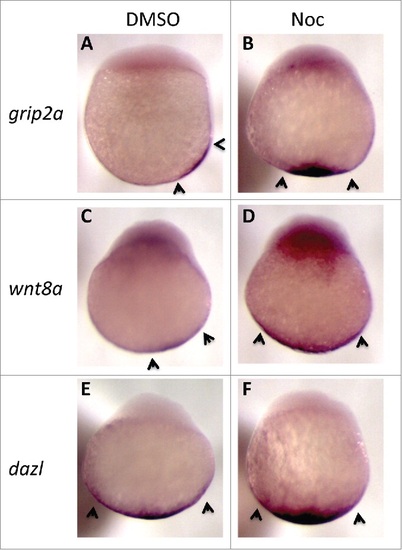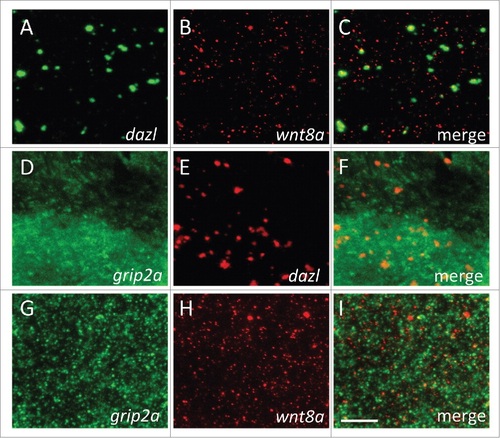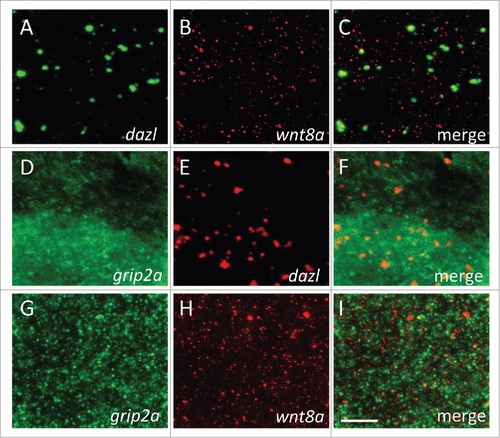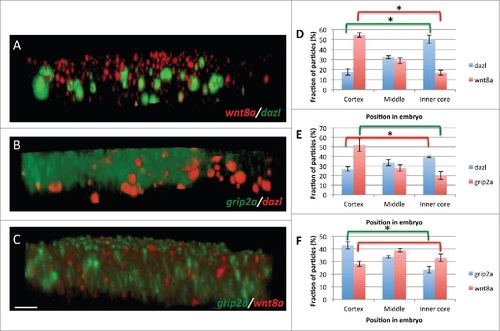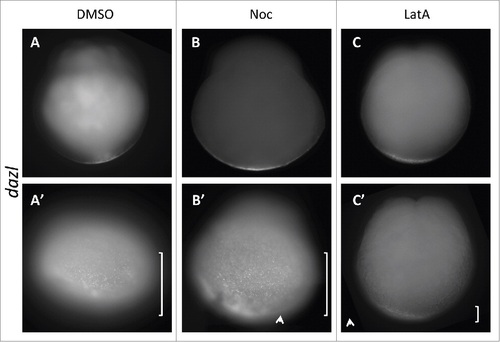- Title
-
Cortical depth and differential transport of vegetally localized dorsal and germ line determinants in the zebrafish embryo
- Authors
- Welch, E., Pelegri, F.
- Source
- Full text @ Bioarchitecture
|
Differential behavior of localized determinants at the vegetal pole of the embryo.(A-D) Asymmetric movement of mRNAs for dorsal factors. Whole mount in situ hybridization shows that grip2a and wnt8a mRNA are localized at the base of the vegetal cortex and experience an off-center shift in control (DMSO-treated) embryos ((A) grip2a: 88%, n = 27 ; (C) wnt8a: 85%, n = 13). Treatment with nocodazole inhibits asymmetric movement ((B) grip2a: 84%, n = 19, (D) wnt8a: 85%, n = 13). (E-F) Symmetric localization of the germ line dazl mRNA. dazl mRNA is also localized to the base of the vegetal cortex in control embryos ((E) 90%, n = 11) and this distribution appears unaffected by nocodazole treatment ((F) 100%, n = 12). Embryos fixed at 40 mpf. Animal pole up, dorsal (when known) right. Arrowheads demark RNA localization domains. |
|
Dual label FISH of pairwise comparisons of wnt8a, grip2a and dazl mRNA localization at the vegetal cortex. (A-C) dazl (green) and wnt8a (red). (D-F) grip2a (green) and dazl (red). (G-I) grip2a (green) and wnt8a (red). In all cases mRNAs localize to discrete units, which do not overlap between different RNAs. Embryos are wild type fixed at 20mpf. Panels are 2-D projections of imaged vegetal cortex samples. Scale bar in (I) represents 5µm for all images. |
|
Figure 3. Colocalization analysis of wnt8a, grip2a and dazl mRNA localization. (A-C) 3-D rendering of dual labeled FISH for pairwise comparisons: (A) wnt8a (red) and dazl (green); (B) grip2a (green) and dazl (red); and (C) grip2a (green) and wnt8a (red). (D-F) Quantification of particles according to cortical depth within a 9 µm section of the vegetal half of the embryo divided into outer (0 – 2.997µm), intermediate (3.087 – 5.994 µm) and most internal (6.084 – 9µm) (see Methods). Particles containing wnt8a and grip2a mRNAs are enriched in the outer section whereas particles containing dazl mRNA are enriched in the inner section. Brackets indicate comparisons evaluated for statistical significance, with green and red bracket colors corresponding to FISH label. Asterisks indicate statistical significance according to a Comparing Means T-test (StatPlus), with p-values as follows: (D) p = 0 .02 and 0.006 for dazl and wnt8a, respectively; (E) p = 0 .001 and 0.07 for dazl and grip2a, respectively; (F) p = 0 .01 and 0.5 for grip2a and wnt8a, respectively. Scale bar in (C) represents 5µm for panels (A-C).
|
|
Fluorescent in situ hybridization to detect animally-directed movement of dazl RNA. (A-A′) In DMSO control embryos, dazl RNPs are transported toward the animal pole (79% with transport, n = 19 ). (B-B′) Movement toward the animal pole appears unaffected by treatment with nocodazole (86% with transport, n = 21 ). (C-C′) Injection of latrunculin A inhibits the transport of dazl RNPs toward the animal pole region (31% with transport, n = 13 ; the effects of injected latrunculin A are expected to be non-uniform due to inhibition of ooplasmic movement and resulting uneven drug distribution, as has been previously observed). Top and bottom panels present different focal planes of the same embryos, focusing on side edge and frontal cortex, respectively. Movement of dazl RNA along the cortex is best visualized in the frontal cortex (extent of RNA movement is highlighted by brackets). Nocodazole exposure was initiated at 5 mpf and latrunculin A injection was carried out at 7–12 mpf. All embryos were fixed at 60 mpf. Injection of carrier solvent to control for latrunculin A injection did not affect dazl RNP transport (85% with transport, n = 7). |
|
Cortical depth and cytoskeletal-based movements involved in axis induction and germ cell determination in the zebrafish. Top two rows present a magnified view of the vegetal cortex, whereas the bottom 2 rows present embryo overviews. In the activated egg, RNAs for both dorsal-inducing factors and germ line determinants are localized to the vegetal pole at different cortical depths. Upon fertilization, microtubules become aligned into parallel bundles and mediate the off-center movement of outer cortex components with respect to the central core (green short arrow). The differential cortical depth of dorsal (wnt8a, grip2a, in the outer cortex) and germ line (dazl, in a more internal layer) RNAs is coupled to this cortical movement and together these processes contribute to a differential transport: dorsal factor RNAs are transported to generate an early, short-range asymmetry, whereas germ line RNAs remain in a symmetric pattern. Three situations concerning the vegetal cortex microtubule (MT) array reorganization at 20 mpf are presented: normal array formation in the left column, and abnormal reorganization (as in hecate/grip2a mutants) or microtubule inhibition (nocodazole-treated embryos) in the right column. Long arrows in the bottom row represent the subsequent paths of long-range factor movement by general transport mechanisms: F-actin-dependent transport of germ cell factors in more internal layers (red arrows) and microtubule-dependent transport of dorsal factors in the outermost cortex (green long arrows). Stippled arrows represent long-range transport system that are competent but nevertheless do not contribute to actual factor transport due to the spatial factor distribution resulting from upstream events in the pathway. |

